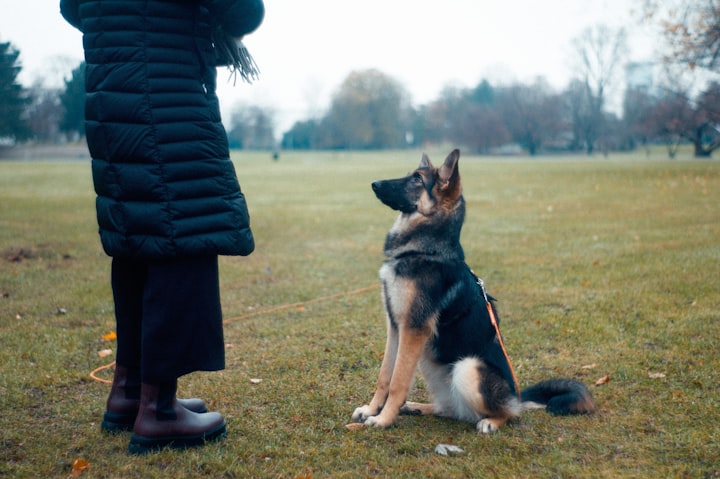Mastering the Art of Dog Training: Proven Techniques for a Well-Behaved Furry Friend
"Unlock the Secrets to a Happy and Obedient Canine Companion"

Explanation of the importance of dog training
Dog training is essential for a number of reasons. First and foremost, it helps to establish a strong and positive relationship between the dog and its owner. This is achieved by teaching the dog to understand and obey commands, which in turn leads to a more well-behaved pet. Additionally, training can help to prevent or address behavioral issues such as barking, digging, and aggression.
Furthermore, dog training can also provide physical and mental stimulation for the dog, which can help to prevent boredom and destructive behavior. It also helps dogs to build confidence and self-assurance.
Moreover, dog training can also help to keep the dog safe. Teaching the dog basic commands such as "come" and "stay" can help to prevent the dog from running off or getting into dangerous situations. Training can also help to teach the dog how to respond in emergency situations, such as if it gets lost or encounters a dangerous animal.
In short, dog training is essential for the well-being of both the dog and its owner. It helps to foster a strong bond between them, can help to prevent or address behavioral issues, and can help to keep the dog safe.
Basic Commands in dog training
Some basic commands for dog training include:
"Sit": This command is used to teach the dog to sit down on command.
"Stay": This command is used to teach the dog to remain in a sitting or standing position until released.
"Come": This command is used to teach the dog to come to the owner or trainer.
"Heel": This command is used to teach the dog to walk by the owner's side and not pull on the leash.
"Off": This command is used to teach the dog to stop jumping on people or furniture.
"Drop it/Leave it": This command is used to teach the dog to release an object from its mouth when told to do so.
"Good boy/girl": This command is used as a positive reinforcement when the dog performs a command correctly.
It's important to note that consistency is key in training. Using the same command words and hand signals each time, providing rewards or treats when the dog performs correctly and most importantly being patient while training your dog.
Behavioral Training
Behavioral training is a type of dog training that focuses on modifying or changing specific behaviors that the dog exhibits. Some common behaviors that are targeted in behavioral training include:
1. Aggression: This can include barking, biting, growling, or lunging at other dogs or people.
2. Separation anxiety: This occurs when a dog becomes anxious or stressed when left alone.
3. Excessive barking: This can include barking at people, animals, or objects that the dog perceives as a threat.
4. Chewing or digging: This can include destructive behavior such as chewing on furniture or digging holes in the yard.
5. House-training: This can include teaching the dog to use the bathroom outside or in a designated area.
Behavioral training typically involves a combination of positive reinforcement, negative reinforcement, and punishment techniques. Positive reinforcement techniques include rewarding the dog with treats or praise when the desired behavior is exhibited. Negative reinforcement techniques include removing a negative consequence (such as stopping a correction) when the desired behavior is exhibited. Punishment techniques include verbal or physical corrections when the undesired behavior is exhibited.
It's important to note that behavioral training should be done by a professional, especially in cases of severe or dangerous behaviors. A professional trainer will be able to evaluate the dog's behavior and develop a customized training plan that is tailored to the specific needs of the dog and the owner.
Advanced Training
Advanced training is the next level of training after a dog has mastered basic obedience commands. It typically includes more complex tasks, such as agility training, scent detection, and service dog training.
1. Agility training involves teaching a dog to navigate an obstacle course which includes jumps, tunnels, and other obstacles. This type of training is a great way to provide mental and physical stimulation for dogs and is a fun way for dogs and their owners to bond.
2. Scent detection training involves teaching a dog to locate a specific scent or odor, such as drugs or explosives. This type of training is typically used for law enforcement or search and rescue work.
3. Service dog training involves teaching a dog to perform specific tasks to assist a person with a disability. This can include tasks such as picking up objects, pulling a wheelchair, or alerting a person to a seizure. Service dog training is typically done by a professional and is a rigorous and time-consuming process.
It's important to note that advanced training should only be attempted with a dog that has already mastered basic obedience commands and has a strong bond with its owner. Additionally, it's important to work with a professional trainer who has experience with the specific type of advanced training you are interested in.
Conclusion
In conclusion, dog training is an important part of responsible dog ownership. Basic training includes commands such as "sit," "stay," "come," "heel," "off," "drop it/leave it," and "good boy/girl." Behavioral training focuses on modifying specific behaviors that the dog exhibits, such as aggression, separation anxiety, excessive barking, and house-training. Advanced training includes agility, scent detection, and service dog training, which are more complex tasks that require a strong bond between the dog and owner and should only be attempted with the guidance of a professional trainer. Consistency, patience and positive reinforcement are important in all types of training.
About the Creator
Rehmat Well-being
Transform your life with us! we empower you with health tips, mindfulness practices, and a holistic approach to a happier life. Nourish your mind, body, and soul and live your best life. Join the journey to radiant health and joyous living!






Comments
There are no comments for this story
Be the first to respond and start the conversation.